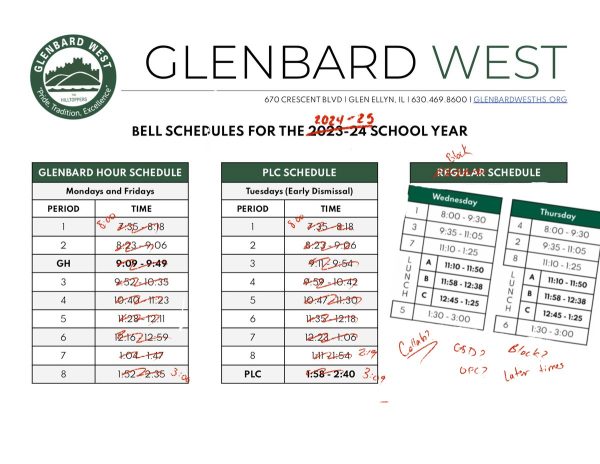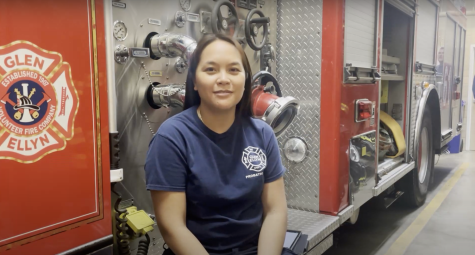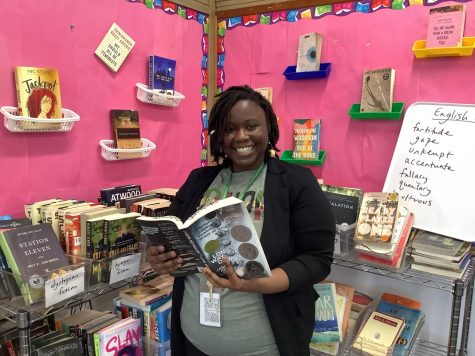Securing the Castle: A Look into Security at West
Safety is a top priority at Glenbard West as school safety continues to be of national concern. On the foundation of trusting relationships and diligence; administration, security guards, school resource officers, and students all work together to keep the school grounds safe.
Assistant Principal of Operations, Stacy Scumaci acknowledges that “when we think of school safety, we typically think of an active shooter, or that type of terrible situation.”
Math Department Chair, Melissa Williams says “if something bad is going to happen, it’s going to happen. We can’t necessarily stop bad things or scary things from happening, but you do what you can to plan.”
Ms. Scumaci states that the administration has a plan for “any kind of emergency that could take place in the building.”
Paul Baird, Head of Prudential Security, describes how “there’s different types of lockdowns depending on the level of an intruder.”
Throughout the year, the school conducts a number of drills including intruder, fire, tornado, other severe weather drills, etc. Ms. Scumaci says “the Regional Office of Education (ROE) requires each school to perform a certain amount of drills.” and that West has “completed all those and we definitely comply with the ROE, but we go beyond that.”
The building is also monitored by school resource officers and security guards hired from Prudential Security. Peter Baker, Dean of Students, says that the purpose of security guards is to “filter out anybody who should not be here at any given time” and “anytime somebody is entering the building, they want to make sure that that is a Glenbard West student or somebody who has permission to be here.”
In her first year as Assistant Principal of Operations, Ms. Scumaci “realized that [West] did not have a secure entry point […] so we created and built our secure vestibule at Door 2.” This year no one can use any entrance other than Doors 2 by Circle Drive or Door 23 by the lunchroom entrance.
The Illinios Terrorism Task Force considers ID policies in the “First Layer” of security measures a school can implement, being cost effective while having a strong impact on overall security. Freshman Grace Mullin feels “very safe and I think that they do good with checking IDs. I think it makes everything more safe and because that way they can make sure that your ID is checked and you can’t come in through the other doors.”
Mr. Baird describes his daily duties as ‘checking IDs of kids coming into school in the mornings, walking patrols, making sure exterior doors are latched, checking in guests, and just checking for strange faces.’ Ms.
Scumaci believes “showing IDs is important.” She goes on to say that “more importantly, Prudential knows our students now. They recognize our students.”
Student Resource Officers Brad Booton and Paul Jimenez are also stationed at West as an added layer of protection. Officer Booton from the Glen Ellyn Police Department says that while on the job he is “looking at people, [he’s] making sure that nobody looks out of place, that everybody is walking with a purpose” he is also ‘making sure doors and windows are closed’ and that nothing “looks out of the ordinary.”
Glenbard West is unique to other schools in the fact that it is an open campus. Ms. Scumaci says “our challenge is space, so it’s not just that we’re open campus because we want [students] to enjoy Glen Ellyn. We’re open campus because of a space issue; our cafeteria is not large enough to hold all our students per period.”
Mr. Baker describes the open campus policy as “a double edged sword for us. I think it’s great that our kids have the ability to do that, but obviously kids coming and going from the building […] can present some concerns for us.”
Freshman Molly Gibson thinks “it’s convenient if maybe you didn’t bring a lunch, maybe go do something, other than that I think it’s maybe a little iffy.”
“70 percent of our students are involved in a club or activity and I think having that connection to the building builds a pretty big trust factor. All those kids that are connected likely have at least one, maybe multiple trusted adults in the building.” ‘So when things are off, they’ll go and tell their coaches, teachers, club sponsors and then they bring that information back to us’ says Mr. Baker.
In a report by the Center for Social and Emotional Learning, research concluded that students in schools with a positive and communal environment show engagement, better socio-emotional health, and lower levels of absenteeism, dropping out, and more.
Social Studies teacher, Christopher Rehfield says getting to know students “can be as simple as having a conversation with them before class about something one hundred percent unrelated to school.” English teacher, Kyle Neiss adds that kids may not understand classroom components “until they know that they are cared for, that they’re cared about, […] and that there’s an instructor that has a vested interest in who they are as a person.”
Officer Booton says “the main thing is to remain approachable. I want students and staff here to feel that they can come to me any time they need.”
Family and Consumer Science teacher, Ronald Brock points out that “when situations arise where you or somebody’s life are in danger, you’re not going to do what somebody you don’t trust tells you to do.”
Mr. Baker notes that “it’s a big school and we have a couple hundred staff members and we don’t always know what’s going on […] So we do rely heavily on our students to let us know that, and that’s why that trust factor is so important.”
Junior Chloe Wanless says “if I had a concern I would probably talk to the deans or something.” Freshman Laila Horvath supposes she would go to “the dean, social worker that I talk to sometimes.” Ms. Mullin thinks “that everyone is really nice and I haven’t really met anyone that made me feel nervous or in danger” and “it’s just like a great environment.”

Ethan Parab is a senior at Glenbard West and a Tech Specialist of The Glen Bard. In addition to newspaper, he enjoys playing tennis, reading, and computer...

Katherine Schlueter is a senior and an Editor-and-Chief of The Glen Bard. She is also an Eagle Scout, and enjoys reading, camping, listening to music,...








